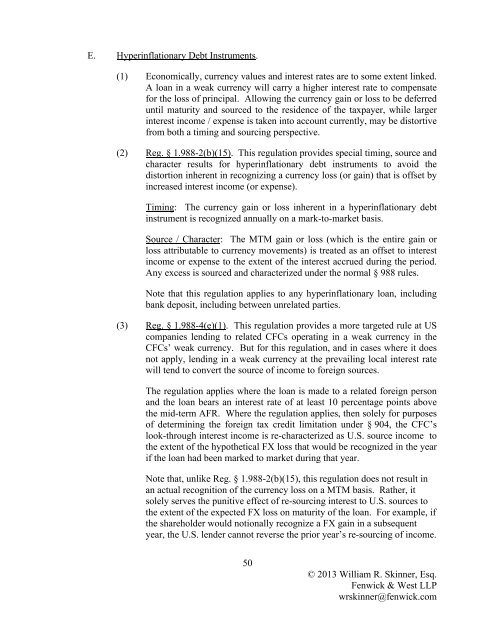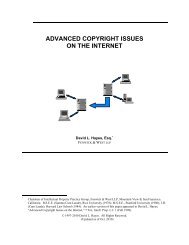International Tax Aspects of Foreign Currency Transactions
International Tax Aspects of Foreign Currency Transactions
International Tax Aspects of Foreign Currency Transactions
Create successful ePaper yourself
Turn your PDF publications into a flip-book with our unique Google optimized e-Paper software.
E. Hyperinflationary Debt Instruments.(1) Economically, currency values and interest rates are to some extent linked.A loan in a weak currency will carry a higher interest rate to compensatefor the loss <strong>of</strong> principal. Allowing the currency gain or loss to be deferreduntil maturity and sourced to the residence <strong>of</strong> the taxpayer, while largerinterest income / expense is taken into account currently, may be distortivefrom both a timing and sourcing perspective.(2) Reg. § 1.988-2(b)(15). This regulation provides special timing, source andcharacter results for hyperinflationary debt instruments to avoid thedistortion inherent in recognizing a currency loss (or gain) that is <strong>of</strong>fset byincreased interest income (or expense).Timing: The currency gain or loss inherent in a hyperinflationary debtinstrument is recognized annually on a mark-to-market basis.Source / Character: The MTM gain or loss (which is the entire gain orloss attributable to currency movements) is treated as an <strong>of</strong>fset to interestincome or expense to the extent <strong>of</strong> the interest accrued during the period.Any excess is sourced and characterized under the normal § 988 rules.Note that this regulation applies to any hyperinflationary loan, includingbank deposit, including between unrelated parties.(3) Reg. § 1.988-4(e)(1). This regulation provides a more targeted rule at UScompanies lending to related CFCs operating in a weak currency in theCFCs’ weak currency. But for this regulation, and in cases where it doesnot apply, lending in a weak currency at the prevailing local interest ratewill tend to convert the source <strong>of</strong> income to foreign sources.The regulation applies where the loan is made to a related foreign personand the loan bears an interest rate <strong>of</strong> at least 10 percentage points abovethe mid-term AFR. Where the regulation applies, then solely for purposes<strong>of</strong> determining the foreign tax credit limitation under § 904, the CFC’slook-through interest income is re-characterized as U.S. source income tothe extent <strong>of</strong> the hypothetical FX loss that would be recognized in the yearif the loan had been marked to market during that year.Note that, unlike Reg. § 1.988-2(b)(15), this regulation does not result inan actual recognition <strong>of</strong> the currency loss on a MTM basis. Rather, itsolely serves the punitive effect <strong>of</strong> re-sourcing interest to U.S. sources tothe extent <strong>of</strong> the expected FX loss on maturity <strong>of</strong> the loan. For example, ifthe shareholder would notionally recognize a FX gain in a subsequentyear, the U.S. lender cannot reverse the prior year’s re-sourcing <strong>of</strong> income.50© 2013 William R. Skinner, Esq.Fenwick & West LLPwrskinner@fenwick.com
















